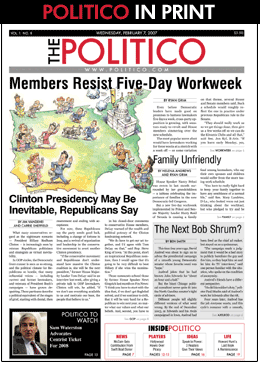Early Days

An early print version of
Politico
.
Courtesy politico.com.
There was no doubt that Politico had done remarkably well for less than two years in business—despite a rough start. Harris and VandeHei had worked for two nights before the launch on January 23, 2007 to produce acceptable copy for the first newspaper edition. Of some 40 articles the largely young and inexperienced newspaper staff had contributed to the first issue, Harris and VandeHei managed to salvage about four after heavy editing; they entirely rewrote a few others. VandeHei recalls his growing panic:
We’d never put out a newspaper. You’ve got to fill the damned book… [I]t was a horrifying experience... And you know what? Time’s up. We’re going live. You can’t postpone it.
They had 24 pages to fill. They managed to shrink some of the yawning space with promotional ads for the website, politico.com, and illustrations by Politico Editorial Cartoonist Matt Wuerker. “We just somehow managed to fill the paper,” VandeHei recalls. Still, neither he nor Harris was happy with the result. Says VandeHei of the first issue: “It was beyond terrible.” The two were happier with the website—which went live at 5:07 a.m. on January 23, 2007—but even that was far from perfect. It had a spare design emphasizing three lead stories, four blogs by prominent political reporters, three photo sideshows, and about a dozen other features by Politico correspondents. Including blog posts, the website featured about 25 articles on its first day.
Harris was mostly relieved that they had met their deadline with a reasonable product. “I just hope people will judge us over time,” he told Washington Post media reporter Howard Kurtz. “We had never expected to create a revolutionary new brand of journalism on Day One.” [1] After its first week, Kurtz wrote of the site:
The political-junkie Web site, led by two former Washington Post reporters, wasn't as jam-packed as I expected, or as colorful, and is rarely updated during the day. In fact, most of what is on politico.com—and the print version, distributed free mainly on the Hill—could easily have run in an Old Media relic like this newspaper. It strikes me as solid and substantive, but not knocking anyone's socks off. [2]
Work in progress. Harris, VandeHei, and Chief Technology Officer Ryan Mannion considered the website in particular a work in progress. They solicited reader feedback about the website’s design—which column widths and layouts were easiest to read, for example—and content. In its first iteration, politico.com’s front page included a poll, labeled “The Poll itico,” that asked readers what areas of the site they would like to see expanded, and offered a choice among Capitol Hill news, news about lobbyists, news about Congress, videos and pictures, and chats and forums.
On the technical side, Mannion had warned Harris and VandeHei that many problems with the website would not become apparent until after the launch. For example, it was impossible to gauge beforehand how much traffic the site would attract, and thus how many servers would be required to support it. VandeHei and Harris did not know whether to expect a few dozen readers, a few thousand or a few million.
But Politico did have the advantage of substantial free publicity. Its nationally-known reporters brought their own reputations, readers, and networks of sources with them from the major publications they had left. Mike Allen of Time , political writer Roger Simon from Bloomberg News, and Ben Smith of the New York Daily News were all on staff. Several political and national news outlets had profiled the new venture. In addition, Media Director Kim Kingsley, whom VandeHei and Harris had hired from the Washington Post , had devoted the weeks leading up to the launch to booking Politico correspondents on television political shows, creating additional exposure for the news organization.
To explain their project to readers, Harris and VandeHei composed a mission statement, which ran both in the newspaper and on the website. In it, they hailed the quality of Politico ’s writers, and promised to report “with enterprise, style and impact.” Politico aimed to focus on the “backstories” behind the daily national political news. They continued:
Reading a story should be just as interesting as talking with the reporter over a sandwich or a beer. It's a curiosity of journalism that this often isn't true. The traditional newspaper story is written with austere, voice-of-God detachment. These newspaper conventions tend to muffle personality, humor, accumulated insight—all the things readers hunger for as they try to make sense of the news and understand what politicians are really like. Whenever we can, we'll push against these limits. In the process, we'll share with readers a lot more of what we know instead of leaving it in our notebooks. [3]
[1] Howard Kurtz, “Politico: Niche Website Isn’t Yet a Notch Above,” Washington Post , January 29, 2007.
[3] John Harris and Jim VandeHei, “Welcome to Politico,” Politico , January 23, 2007.